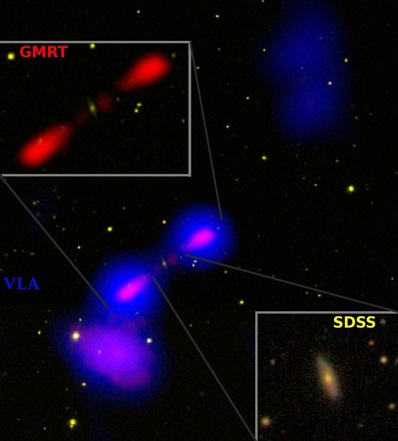



|

|

Unique galaxy tells tantalizing tale
DR EMILY BALDWIN
ASTRONOMY NOW
Posted: 31 August 2011


A spiral galaxy with a unique combination of characteristics, including powerful jets, is giving astronomers insight into the growth of galaxies early in the Universe.
The galaxy is 1.7 billion light years away and known as Speca, an acronym for Spiral-host Episodic radio galaxy tracing Cluster Accretion, and is only the second spiral galaxy seen to produce large jets of particles moving at nearly the speed of light. Furthermore, it is only one of two galaxies that host jets that record activity in three distinct stages.
Speca was first uncovered in an image that combined data from the visible-light Sloan Digital Sky Survey and the FIRST survey conducted with the National Science Foundation’s Very Large Array (VLA) radio telescope, with follow up observations from the Lulin optical telescope in Taiwan, Giant Meterwave Radio Telescope (GMRT) in India and ultraviolet data from NASA’s GALEX. Images were also studied from the NRAO VLA Sky Survey (NVSS).

Composite image of Speca: Optical SDSS image of the galaxies in yellow, low resolution radio image from NVSS in blue, high resolution radio image from GMRT in red. Image: Hota et al., SDSS, NCRA-TIFR, NRAO/AUI/NSF.
The VLA FIRST radio images revealed one pair of radio-emitting lobes emanating from the galaxy, while VLA NVSS revealed a distinct pair of lobes further away. The GMRT images confirmed the second pair and in turn uncovered a smaller pair of lobes close to the galaxy, likely representing the most recently ejected jet particles.
"The most recent jets are likely a few million years old; the middle pair is likely a few tens of millions of years old and the relic lobe may have left the central black hole less than 500 million years ago, when most of the massive stars in the galaxy, seen to the GALEX UV data, were formed," Ananda Hota of the Academia Sinica Institute of Astronomy and Astrophysics (ASIAA), Taiwan, tells Astronomy Now.
Speca, and the 60-some other galaxies in a cluster with it, may represent typical behaviour of young galaxies and clusters in the early Universe, a turbulent epoch that would have seen galaxies accreting material, and colliding and merging with each other to trigger bursts of star formation. Jets of particles powered by supermassive black holes at a galaxy's centre are not uncommon, but only Speca and one other spiral galaxy have been seen to produce large jets such as these.
"Spiral-host large radio galaxies are rare, likely because gaseous discs, capable of forming stars, have probably been removed by multiple episodes of violent jets during several merger events that happened over several billion years of galaxy evolution," explains Hota. "We think these old, relic lobes have been ‘re-lighted’ by shock waves from rapidly-moving material falling into the cluster of galaxies as the cluster continues to accrete matter."
The broad range of data for this galaxy was key to unravelling its history. "The rare three episodes of jets seen in Speca suggest that either detection probability is low or occurrence is low," adds Hota. "We know radio lobes are short lived, but with e.g. LOFAR (LOw Frequency ARray) we will detect many more relic lobes to understand the issue. Speca is the discovery of a 'missing link', and finding more galaxies like Speca is the next step."
|

|

|

|
|



